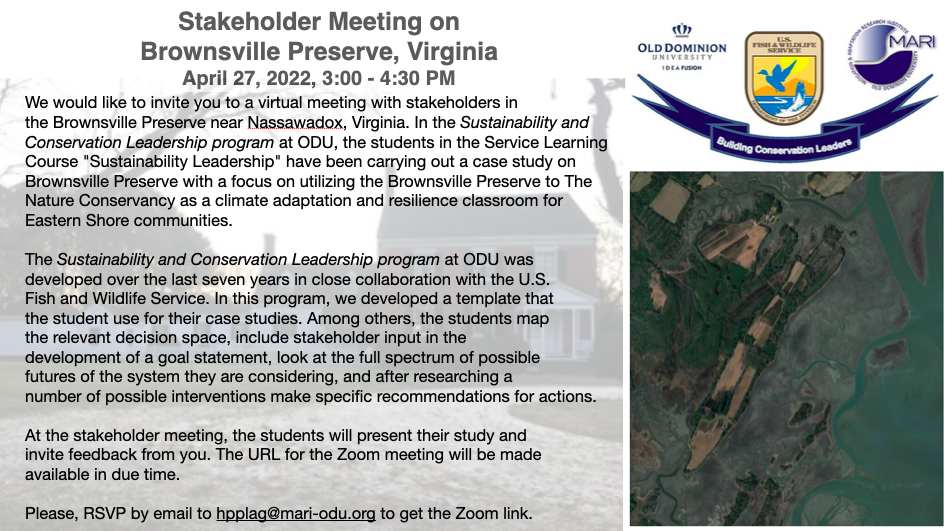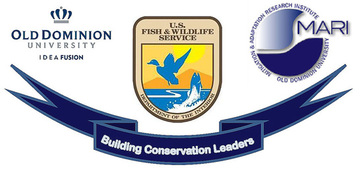Introduction
Creating a more sustainable society presents a serious challenge and at the same time an enormous opportunity. Most sustainability-related challenges present wicked problems to society and can best be addressed in a participatory collaborative approach. The students in this course gained experience in participating in such an effort focusing on a real-world problem.
The real-world problem addressed in this course relates to the future of the Virginia Coast Reserve and the Brownsville Preserve on the Eastern Shores under climate change and sea level rise and the approaches that can be taken to mitigate impacts and adapt to changes. The students will cary out a case study using the MARI case study templete with the goal to make recommendations to the Nature Conservancy.
The problem will be tackled using a transdisciplinary collaborative approach. A core element of this approach is a participatory modeling effort. Each student is representing a relevant stakeholder group and bringing the views, interest and knowledge of this group into the participatory modeling effort. By doing this, the students take leadership for the groups they represent and at the same time integrate into the participatory and collaborate deliberations about the wicked problem. Considering all aspects of balancing the needs of thriving communities and healthy ecosystems in a systems thinking mindset introduces them to complexity. Their effort to develop conceptual and stock and flow models (SFMs) that represent all relevant stocks and flows and the essential variables that are important for impacting the trajectory of the system of systems model helps to develop their skills in addressing the complexity inherent to real-world problems.
Sustainability also requires foresight with respect to the wide spectrum of possible futures, and the students' efforts to develop this foresight utilizes a scenario-based approach to explore the spectrum of possible futures under climate change and a dynamic development of population and economy. Based on an understanding of the relevant decision space for the watershed considered, the students will develop a set of possible interventions to ensure a trajectory of the area towards the desirable future of thriving communities embedded in a healthy environment. Finally, they will make recommendations for viable interventions.
Stakeholder Meeting, April 27, 2021

|
Learning By Experience: Reflections of the Students
The course is part of a tripple loop of learning by experience. In the first loop in the 466W/566 courses, students have been carrying out individual case studies of real-world wicked problems. By doing so, they got introduced to the case study template and the transdisciplinary approach to wicked problems, which requires systems thinking. In 467/567, they go through the second loop in a service learning setting, in which the students work as a group on a case study of a societal problem for a stakeholder. The third loop is the subsequent internship, in which the students again cary out an individual case study of a problem relevant to the host institution.
In all three loops, the students prepare individual reflections on the learning experience and the outcomes for them personally. In the 467/567 courses, these reflections include a reflective video and personal written reflections.
The Case Study Project: Utilizing Brownsville Preserve as a Climate Adaptation and Resilience Classroom for Eastern Shore Communities
In Spring 2022, the service learning project will most likely focus on the adaptation to climate change and sea level rise for a segment of the Virginia Coast Reserve and the Brownsville Preserve on the Eastern Shores. The Brownsville Preserve on the Eastern Shores provides a habitat where birds and other wildlife abound. The reserve maintained by The Nature Conservancy provides many services to the neighboring communities. Climate change is expected to have a number of impacts on the Preserve.
The 14 undeveloped barrier and marsh islands of the Virginia Coast Reserve constitute the longest expanse of coastal wilderness remaining on the east coast and help to protect Eastern Shore communities from storm surges and sea level rise, as well as providing critical wildlife habitat. Sea level rise poses serious threats to this important coastal reserve. Building on the case study done in 2020, this year the students focused in integrating the societal environment around the Brownsville Preserve into the conceptual model and asking the question what contribution the Nature Conservancy and the Brownsville Preserve could make to the communities on the Eastern Shore tackling the challenge of climate change adaptation.
Case Study Report
The case study report prepared in collaboration of all students provides recommendation for The Nature Conservancy.
|

